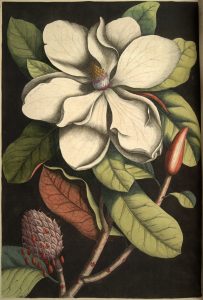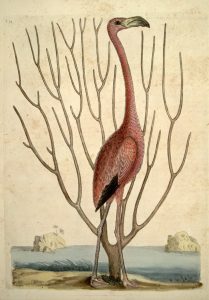
Mark Catesby’s two-volume set of The Natural History of Carolina, Florida and the Bahama Islands was published in 1754. Over 250 years later, this printed edition is housed in just 45 libraries globally. Describing and illustrating North American flora and fauna from an 18th-century naturalist’s perspective, this work has become a rare and important artifact for historians and scientists alike.
Catesby (1682-1749), an English naturalist, made his first trip to North America in 1712. Over the next seven years, he explored and collected specimens from Virginia, the home of his sister and her husband.[1] At the time, this area remained relatively unexamined by European naturalists and he was able to refine his skills in field research, sketching, and specimen collection.[2] With the financial backing of the Royal Society, Catesby returned to the New World in 1722 to study and document the flora and fauna of South Carolina, Georgia, and the Bahamas.[3] Working in a time before Carl Linneaus’s famous classification system, Catesby focused his attention on the interdependence of New World flora and fauna as well as the utilization of natural resources, such as trees and shrubs due to their potential use in building, food, and medicine.[4] He also paid specific attention to birds, as he believed them to be the “most numerous and beautiful of animals” as well as a valuable food source.[5] The information Catesby collected and the sketches he made during this four-year trip became the basis for what we now know as The Natural History of Carolina, Florida and the Bahama Islands.

This work is historically significant because it is believed to be the earliest printed work to both illustrate and describe North America’s wild life.[6] Originally published in eleven sections from 1734-1747, this work was available by subscription.[7] It quickly became one of the “most expensive publications of the eighteenth century, costing twenty-two guinea for a complete set.”[8] The first edition’s large folio format, which included 220 hand colored plates, sold 166 copies.[9] In 1754, it was republished in a two-volume set. Its popularity and the amount of surviving materials from Catesby’s lifetime show “the importance of natural science in the formation of the British Empire during the first half of the eighteenth century.”[10]
The University of South Florida owns one of these rare two-volume sets and it is currently housed in USF Libraries’ Special Collections. Digital Scholarship Services has digitized ten of its colorful illustrative plates. These digitized items are available through USF Digital Collections.
Explore the Catesby Collection of illustrative plates: https://digital.lib.usf.edu/catesby/all
REFERENCES
[1] Amy R. Meyers and Margaret Beck Pritchard, “Introduction: Toward an Understanding of Catesby,” in Empire’s Nature: Mark Catesby’s New World Vision, edited by Amy R. Meyers and Margaret Beck Pritchard (Chapel Hill and London: The University of North Carolina Press, 1998), 2.
[2] Meyers and Pritchard, “Introduction,” 2, 5.
[3] “About,” Catesby’s Natural History of Carolina, Florida, and the Bahama Islands, University of North Carolina University Libraries, Accessed December 5, 2019, https://cdn.lib.unc.edu/dc/catesby/about.html.
[4] Meyers and Pritchard, “Introduction,” 9.
[5] Meyers and Pritchard, “Introduction,” 9.
[6] Meyers and Pritchard, “Introduction,” 24-25.
[7] David R. Brigham, “Mark Catesby and the Patronage of Natural History in the First Half of the Eighteenth Century,” in Empire’s Nature: Mark Catesby’s New World Vision, edited by Amy R. Meyers and Margaret Beck Pritchard (Chapel Hill and London: The University of North Carolina Press, 1998), 93.
[8] Brigham, “Mark Catesby and the Patronage,” 93.
[9] Brigham, “Mark Catesby and the Patronage,” 93.
[10] Meyers and Pritchard, “Introduction,” 1.